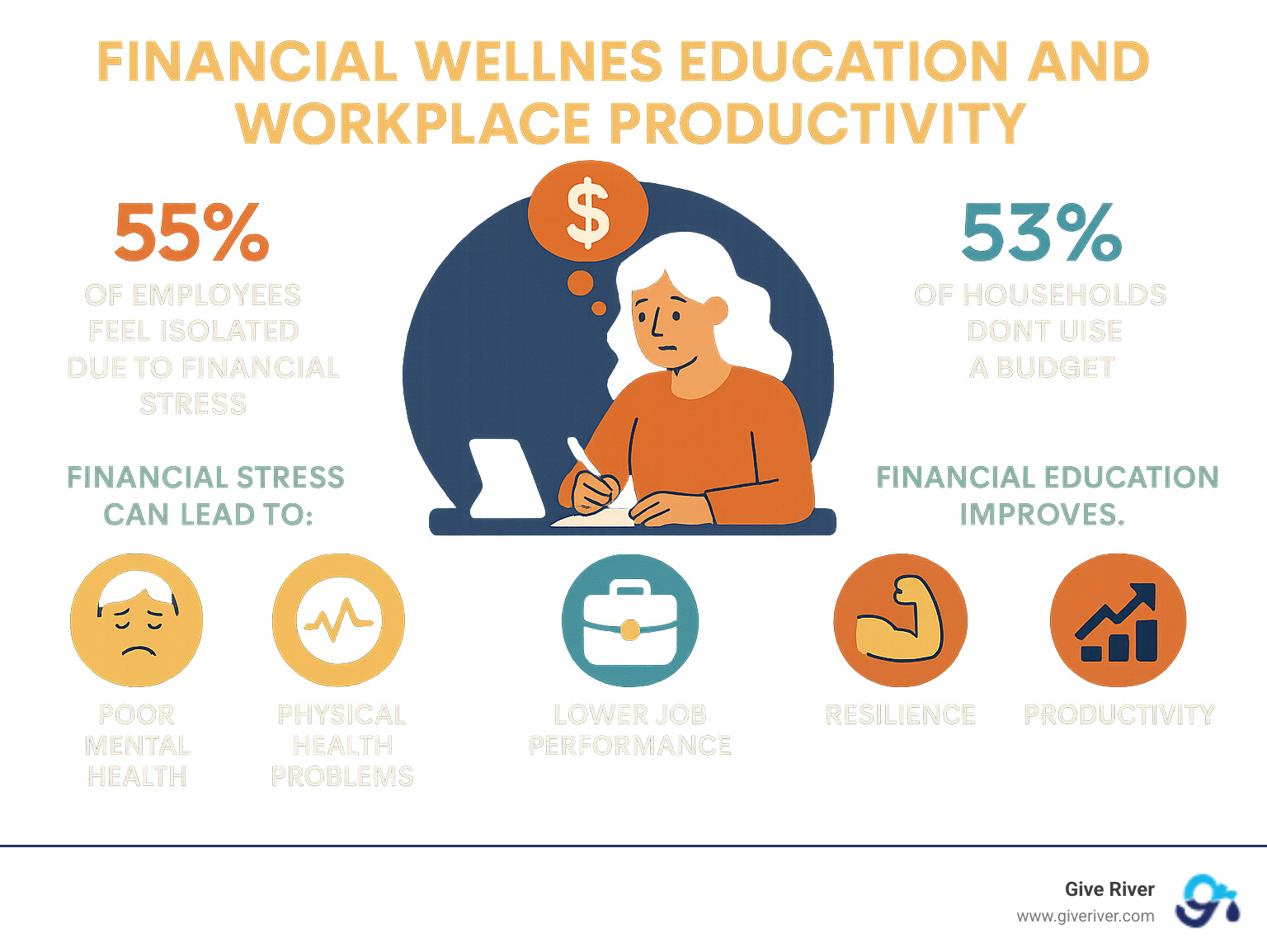Unlock Your Financial Future: Comprehensive Wellness Education
Unlock your future! Learn how financial wellness education boosts well-being & productivity. Master budgeting, debt, and investing for a resilient life.

Why Financial Wellness Matters More Than Ever
Financial wellness is more than just having money; it's a state of confidence and security in managing your financial life. It’s achieved through financial wellness education, which equips people with the knowledge and skills—or financial literacy—to make sound decisions about budgeting, debt, savings, and investing.
The need is urgent. With 55% of Canadians feeling more isolated due to rising costs, financial stress has become a workplace crisis. It directly impacts productivity, engagement, and retention. When employees are worried about money, their focus suffers, absenteeism rises, and turnover increases. A staggering 47% of Canadian households don't use a budget, highlighting a critical gap in fundamental money management skills.
At Give River, we've seen how integrating financial wellness education into a holistic employee wellness strategy transforms workplace culture. Addressing an employee's financial health is key to building resilient, thriving teams.

The Pervasive Impact of Financial Stress
Financial stress isn't contained to an individual's personal life; it has far-reaching consequences that affect overall well-being.
- Mental and Physical Health: Constant worry over debt and expenses can lead to anxiety, depression, and sleep loss. This chronic stress can also manifest physically, contributing to high blood pressure, weakened immunity, and other health problems.
- Relationships and Social Life: Financial strain often leads to social isolation as people cut back on activities. It can also create tension in relationships with family and friends, damaging crucial support networks.
- Workplace Productivity: An employee preoccupied with financial troubles is less engaged and productive. This "presenteeism" results in lower-quality work and higher turnover, impacting the entire organization. Learn more about this connection in our guide on Employee Wellness and Productivity.
Tackling financial stress through education is not just beneficial for individuals; it's essential for building a healthier, more stable workforce. We explore solutions in our discussion on Workplace Health and Wellness Programs.
The Core Pillars of Financial Wellness Education

Effective financial wellness education is built on a foundation of learnable skills. The four essential pillars are budgeting, debt management, savings strategies, and investment basics. Mastering these creates a framework for long-term financial resilience.
Understanding the Key Components
- Budgeting and Expense Management: A budget is a proactive plan for your money. While only 53% of Canadian households use one, it's the most powerful tool for gaining financial control. Popular methods include the 50/30/20 rule, zero-based budgeting, and the envelope system.
| Budgeting Method | Description | Best For |
|---|---|---|
| 50/30/20 Rule | Divides after-tax income into 50% needs, 30% wants, 20% savings. | Simplicity and flexibility. |
| Zero-Based Budget | Assigns every dollar a job, so income minus expenses equals zero. | Maximizing every dollar and aggressive debt payoff. |
| Envelope System | Uses cash in labeled envelopes for spending categories. | Visual learners and preventing overspending. |
Debt Management: Education helps reframe debt from an overwhelming burden to a manageable challenge. It involves understanding interest costs and using strategies like the "debt snowball" (paying off smallest debts first) or "debt avalanche" (tackling highest-interest debt first).
Savings and Emergency Funds: Having three to six months of living expenses saved provides a crucial safety net, turning potential crises into mere inconveniences. This security is fundamental to reducing financial stress.
Introduction to Investing: This pillar demystifies concepts like compound interest and diversification. It empowers individuals to make their money work for them, helping them grow wealth for long-term goals.
These components work in a virtuous cycle: budgeting frees up cash for savings and debt repayment, which in turn allows for investing. Learn more about structuring these programs in our guide to Corporate Wellness Initiatives.
The Role of Digital Tools in Modern Financial Education
Technology makes financial education more accessible and engaging than ever. Digital tools put powerful guidance directly into employees' hands.
- E-learning platforms and online courses from sources like the Financial Consumer Agency of Canada offer self-paced learning.
- Budgeting apps like Mint and YNAB automate tracking and provide real-time insights.
- Financial calculators and interactive games make complex topics like retirement planning understandable and even fun.
These resources democratize financial knowledge, breaking down barriers of time and cost. Our Corporate Wellness Tools Ultimate Guide offers more insights on integration.
How Organizations Can Champion Financial Wellness
Companies that champion financial wellness education see a direct return in productivity, engagement, and retention.
- Offer practical learning opportunities: Host workshops, webinars, or "lunch and learns" on topics from budgeting to understanding benefits. Partner with credible sources like CPA Canada or use resources from the Government of Canada's financial literacy programs.
- Provide access to expert guidance: Confidential one-on-one financial counseling can be life-changing for employees facing specific challenges.
- Integrate financial wellness into a holistic platform: Financial health is a key part of overall well-being. While recognition platforms like Bonusly or Kudos are excellent for boosting morale, they are not designed to address the root causes of financial stress.
At Give River, our 5G Method offers a more comprehensive solution by integrating financial wellness into a complete employee support system. We provide practical guidance alongside tools for recognition, growth, and community impact, supporting the whole person. This investment builds a more resilient and productive workforce, a cornerstone of effective Employee Health and Wellbeing Initiatives.
Building a Financially Resilient Future

Building a financially resilient future means feeling empowered to set goals and create long-term security. Financial wellness education provides the actionable knowledge to achieve this freedom, fostering control and optimism. At Give River, our holistic approach makes financial health a key component of overall well-being, helping people build a brighter future.
Tailoring Education for Every Life Stage
Effective financial wellness education is not one-size-fits-all; it must be custom to an individual's life stage to be relevant and impactful.
- Young Adults: The focus is on foundational skills like managing student debt, building credit responsibly, creating a first budget, and the power of starting to save early.
- Mid-Career and Families: Priorities shift to major milestones. Education should cover advanced topics like planning for homeownership, family budgeting, saving for education, and growing investments.
- Pre-Retirees: The goal moves from wealth accumulation to preservation. Key topics include maximizing retirement income, legacy planning, managing healthcare costs, and fraud protection.
Adapting content to these stages helps individuals steer their unique challenges with confidence. Our Corporate Wellness Platforms offer personalized content for these diverse needs. To see how we can help your organization, explore comprehensive wellness solutions.
Conclusion
Financial wellness education is fundamentally about empowering people to lead healthier, less stressful lives. By providing the right knowledge and tools, we can transform financial anxiety into confidence and control. This education, now more accessible than ever through digital tools, is key to tackling the financial stress that impacts mental health, relationships, and workplace focus.
Organizations have a critical role and opportunity to champion this cause. Financially secure employees are more engaged, focused, and loyal, which directly benefits the business.
At Give River, we believe in a holistic approach to employee fulfillment. While recognition platforms like Bonusly and Kudos boost morale, they often miss the underlying financial stress employees face. Our unique 5G Method stands apart by integrating robust financial wellness education with personal and professional growth, gamification, and community impact. We are committed to equipping individuals with the financial resilience they need to truly thrive, addressing a fundamental need that pure recognition platforms are not designed to meet.
Investing in financial wellness isn't just good for the bottom line; it builds more resilient, productive, and happier teams, creating a brighter future for everyone.




